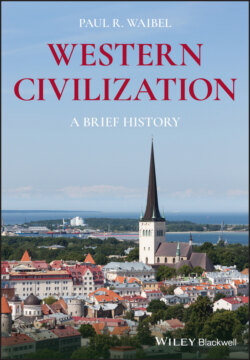Читать книгу Western Civilization - Paul R. Waibel - Страница 56
Manorial System
ОглавлениеThe manorial system was the economic side of feudalism. Its function was to provide for the livelihood of those living on the manor and support the feudal system by providing the wealth with which the lord of the manor fulfilled his feudal obligations to his lord. As in the feudal system, the serf or peasant swore an oath of fealty to the lord of the manor in a ceremony similar to the one in which the lord received his fief from his lord. This was the personal element. In exchange for his service, the serf, or peasant, received a portion of the manor's arable land to farm, the property element. In addition, he owed a portion of the produce from the land he farmed to the lord of the manor.
A manor was meant to be a self‐sufficient unit. It consisted of both arable and non‐arable land. The arable land was that which could be farmed. It was usually divided into three large fields, which were then divided into strips of about one half‐acre (2023.4 sq. m.) each. The strips were allotted to the peasant families in rotation, so that each received a portion of the good and the bad land. The practice had the added benefit of requiring the peasants to work the land according to a common plan. Scattered throughout the fields in the same manner as those of the peasants was the lord's portion, called the lord's demesne. The peasants were required to work approximately three days each week on the lord's demesne.
Figure 4.2 A Medieval Manor was an economically self‐sufficient world of its own.
The introduction of the three‐field system greatly increased production. Two fields were cultivated each year, one devoted to winter crops and one devoted to summer crops. The third lay fallow so as to replenish its nutrients. An acre (4046.9 sq. m.) would produce about seven bushels (approx. 0.035 cubic meter) of wheat in an average year. Two bushels would be retained for seed for the next year. After the lord's portion and a 10% church tax were deducted, little was left for the serf. Also, a portion was paid to the lord for use of his mill to grind the wheat into flour and for use of the lord's oven to bake the bread. Grain (mostly wheat, but also barley and rye) in the form of bread or gruel was the staple in the serf's diet. Cabbage, onions, peas, beans, and turnips were also a part of the serf's diet.
In addition to the arable land, a portion of the manor consisted of non‐arable land – forest, common pasture, orchard, and meadow. The serfs lived in the manorial village in windowless, one‐room huts with a dirt floor and a hole in the roof to let out smoke from a small fire in the center. During winter, the serf's family shared the space with the farm animals whose presence helped provide some warmth. Since bathing was considered unhealthy, and little attention was paid to personal hygiene by even members of the nobility, it is unlikely that the stench of the animals bothered the residents. The manorial village included a church for the serfs, complete with a priest chosen by the lord of the manor.
The lord of the manor and his family lived in the manor house. It was built as a residence, not a castle for defense. The manor house reflected the wealth and standing of the lord. In general, it included a Great Hall, chapel, living quarters, kitchen, storerooms, and servants’ quarters. If the lord possessed more than one manor, the individual manors were managed by a steward or bailiff.
Together, the feudal and manorial systems provided a measure of stability during an era that lacked any meaningful central authority and lacked a money economy. Whether lord or serf, each held a recognized place in the divinely ordained hierarchical order referred to as the Great Chain of Being. Each person enjoyed all the rights, privileges, and obligations of the social class to which the individual belonged. As hard as the life of a serf often was, the serf possessed customary rights that the lord of the manor could not ignore. Of course, reality seldom approximated theory. Whether lord or serf, life in the Middle Ages was harsh and short and always filled with a monotonous routine, where the only hope of relief came with death and an eternity spent in God's presence, access to which was controlled by the church.
